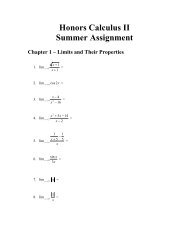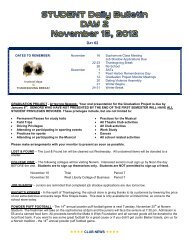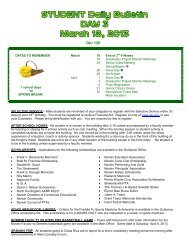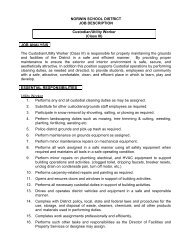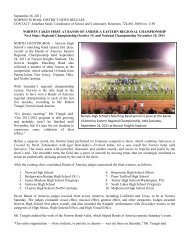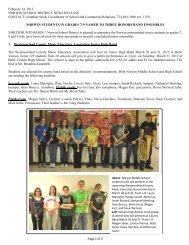Science fair rules 2013 - Norwin School District
Science fair rules 2013 - Norwin School District
Science fair rules 2013 - Norwin School District
You also want an ePaper? Increase the reach of your titles
YUMPU automatically turns print PDFs into web optimized ePapers that Google loves.
III. THE EXPERIMENT<br />
Once your proposal is approved, follow the time line on the web site.<br />
A. Research:<br />
1. First, find out as much as you can about your topic. Look up information in<br />
science books<br />
and magazines or interview a scientist or specialist in the area you are studying.<br />
B. State your hypothesis:<br />
1. This is sometimes called an "educated guess.” What do you think you will<br />
discover once your experiment is finished? Your hypothesis does not have to be<br />
correct, rather, you will be doing the experiment to test it and see if it was right. A<br />
sample hypothesis might be,” I expect the air pressure in a football to change by<br />
10% from the hottest day to the coldest day.”<br />
C. Begin Your Experiment:<br />
1. Make measurements and record your data in metric units whenever possible.<br />
2. Use a control when applicable.<br />
a. In the case above we will have two footballs. One will be heated and cooled.<br />
The other will remain at room temperature. The unaffected one is called the<br />
control and allows us to make sure that it is the heating and cooling of the other<br />
one that is causing the change in the pressure, and not some other factor (such as<br />
humidity or cosmic rays). Each time we measure pressure in our experimental<br />
sample we will also check the pressure in our control sample. By measuring the<br />
control, we will also see how much air is lost each time we insert the pressure<br />
gauge into the ball.<br />
3. Manage your variables properly. All external influences must stay the same<br />
(controlled variables) except the one you are testing (manipulated variable).<br />
a. In our sample experiment, we must use the same footballs, thermometer and<br />
pressure gauge each time and keep all other factors (humidity. etc.) constant. The<br />
only factor we will change is the temperature. We will heat the experimental ball<br />
in an oven and cool it in a freezer, then measure and record the pressure inside the<br />
ball.<br />
4. Have a sufficiently large sample size and perform your experiment more than<br />
once. If you do the same experiment ten times will the results be similar?<br />
Do you think all footballs will react the same way? Should you try other ones to<br />
be sure? Is it okay to compare footballs from different manufacturers?





